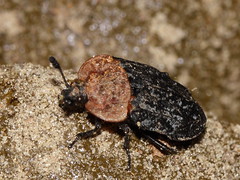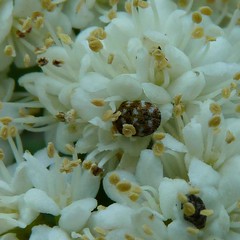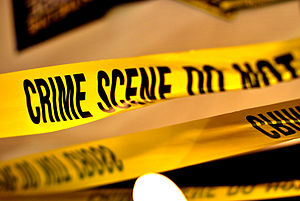| . (Photo credit: Wikipedia) |
consider your tolerance before viewing.
Your character arrives at the crime scene ready to put her full professionalism into play and solve the crime.
Uh oh! They've found a body. Your heroine calls in the coroner because it's required by law. But very quickly, your heroine realizes from the state of the remains that the body has been decomposing for over 72 hours. So she makes two more calls:
| Blow-flies (Photo credit: Wikipedia) |
* A forensic entomologist to process the bugs.
- Blog Link to Crime Scene 101
- Blog Link Coroner/Death
Investigator
- Blog Link Algor, Livor, and
Rigor Mortis
- Blog Link Forensic
Anthropologist
* In the first 72 hours there are more precise ways to
determine time of death than by using insect evidence.
* After 72 hours insect evidence is the most accurate
and possibly the only way to determine time of death.
A forensic entomologist - deals with any bugs that would show up in the court of law.
Video Quick Study (2:42) a forensic entomologist talks about his job.
Sometimes, because of access, distance, or budgets, getting a forensic entomologist to the crime scene is not possible. A CSI can gather the evidence.
| A Typical Crime Scene Kit (Photo credit: Wikipedia) |
Video Quick Study (1:36) Review of a field forensic entomology kit.
* Different species should be kept separate
* Insects collected from different body parts should be kept
separate.
* Maggot clusters should be documented, photographed, and
temperatures obtained.
* The specimens should be labelled with:
- date and time
- name of the collector
- stage of insect development at time of the collection
* When the bugs are collected your character will want to have 2
vials:
- Sample One - contains alcohol (the bugs die) this shows:
1. what stage of development the bugs were in when they were
collected
2. helps the emtomologist to define the approximate time of death
3. can be used in court as evidence.
- Sample Two - keeps the specimens alive. Add a dampened paper
towel and cover with dry paper towel held on with a rubber band.
This allows the entomologist to incubate the insects in their lab
and determine a more specific time line.
* Soil samples
* Weather at the time of collection
including: shady? sunny?
raining? temperature?
* Vegetation in the area
* Death site including elevation
and map coordinates
* The state of the remains
* Were the remains buried? How
deeply?
* What clothes or wrapping
surround the remains?
* Anything else that the CSI thinks
might help inform the process.
Photography is VERY helpful
Video LONG Study (15:11) Prt 1, Canadian entomologist discussing crime.
Video LONG Study (6:42) Prt 2
separate.
* Maggot clusters should be documented, photographed, and
temperatures obtained.
* The specimens should be labelled with:
- date and time
- name of the collector
- stage of insect development at time of the collection
* When the bugs are collected your character will want to have 2
vials:
- Sample One - contains alcohol (the bugs die) this shows:
1. what stage of development the bugs were in when they were
collected
2. helps the emtomologist to define the approximate time of death
3. can be used in court as evidence.
- Sample Two - keeps the specimens alive. Add a dampened paper
towel and cover with dry paper towel held on with a rubber band.
This allows the entomologist to incubate the insects in their lab
and determine a more specific time line.
Other data that will help a forensic entomologist make sound scientific inferences in the laboratory include:
* Habitat: ex desert, vegetative, meadow, woods| Ruler in use at a mock crime scene (Photo credit: Wikipedia) |
* Weather at the time of collection
including: shady? sunny?
raining? temperature?
* Vegetation in the area
* Death site including elevation
and map coordinates
* The state of the remains
* Were the remains buried? How
deeply?
* What clothes or wrapping
surround the remains?
* Anything else that the CSI thinks
might help inform the process.
Photography is VERY helpful
Video LONG Study (15:11) Prt 1, Canadian entomologist discussing crime.
Video LONG Study (6:42) Prt 2
Okay, let's get to the bugs themselves
| English: Describing the relationships between carrion insect trophic specializations and decomposing remains, adapted and simplified from K.G.V. Smith, A Manual of Forensic Entomology, 1986 (Photo credit: Wikipedia) |
Some terms:
* Nacrophagous Species - feed on dead things.
* Omniverous Species - will eat most anything
* Predators - come to eat the necrophagous and omnivorous
species of insects
species of insects
* Parasites - are brought in by the other insects
* Adventive species - can be particularly informative. If the
entomologist finds sub-types of species whose habitats are in a
different geographical location, they can determine that the body
had been moved.
entomologist finds sub-types of species whose habitats are in a
different geographical location, they can determine that the body
had been moved.
Video Quick Study (1:49) Entomologist looks at the air filter on a car to determine if the suspect drove across the United States
to commit a murder.
to commit a murder.
The first on the scene is the blow fly.
* Blow flies can smell death and
can be there in mere moments.
can be there in mere moments.
* They lay their eggs immediately
in openings. This can
in openings. This can
mean: mouth, eyes, nose, ears,
anus and vagina, and
anus and vagina, and
importantly, wounds.
Now why is that important? If the remains have decayed past the point of recognition, finding the maggot mounds can help identify where that person might have been injured.
Why might this be bad? - When the eggs hatch and the larvae
starts to eat they are:
starts to eat they are:
* destroying the facial features of the deceased, making
identification more difficult
identification more difficult
* can damage the wound margins making forensic wound study
difficult.
difficult.
Quick review of your Biology 101 class - here are the stages of blow fly life:
1. egg is laid - NOTE: flies
are only active during
daylight. If the person dies
at night, the first eggs
won't be laid until
morning.
are only active during
daylight. If the person dies
at night, the first eggs
won't be laid until
morning.
2. maggots come out and start to consume the corpse
3. larvae grows and eats
4. The larvae are full and stop eating. They migrate away from the
body to pupate (hard cocoon-like stage while their DNA
rearranges them into a fly). They like to do this in cool
conditions. They will crawl under rugs, into the clothing
especially seams, pockets, and cuffs, or if this isn't available -
earth.
5. Pupae - because they change color can be aged to a matter of
hours.
6. Emerging as a fly
* This whole cycle takes about 2 weeks depending on:
- Species
- Weather (warmer temperatures creates more activity)
- Quality of the food
- Oxygen levels
- Day length/season
Video Quick Study (6:52) Close up video of blow fly life cycle.
Video Quick Study - Murder case in Hawaii where the body was wrapped in blankets.
.
* If a body is discovered in the first month postmortem interval, PMI, entomologists can be accurate towithin a day.
* After first generation of blowflies has developed, the
entomologist looks at the succession of insects. This is
used when the corpse is dead for a month or more. The wave of
insects overlaps.
Insect Arrival Comes in Waves
| English: Blow flies (Photo credit: Wikipedia) |
1. Flies - attracted by the
decomposition odor arrive
immediately. They like fresh
bodies because of water
content.
| Oiceoptoma thoracicum (Silphidae) (Photo credit: gbohne) |
during putrefaction stage
body liquids are starting to expel from
the corpse, lot's of odor
more and more insect activity. (flies
and wasps will also be
there)
| Closer view of a carpet beetle (Photo credit: Dendroica cerulea) |
an becoming leathery, some bone is starting to protrude out of
decomposition. The carpet beetles come to eat the hair, skin
and bone. Coffin flies, cockroaches and flies are there as well.
Video Quick Study (8:53) a forensic teacher takes you through the insect stages.
Video Quick Study (7:31) video of an animals decomposition, focusing on insect activity
Interestingly, bugs:
* can carry corpses dna
* can ingest drugs
Video Quick Study (2:45) Student's on site
Video Quick Study (6:38) Student forensic entomologists.
* Bugs can only tell the entomologist how long the body has been
available to the bugs. So for example, if the body was in a deep
freezer and then removed and put in the woods, the timing would
be based on when the body was available to the bugs.
* In much of Canada and northern United States, cold winter
months mean entomologists cannot use insects to determine time
of death.
* In the summer, a body can decompose down to bones in as little
as two weeks.
* Decomposition in water - standard insects don't apply but other
organisms do.
| CRIME SCENE DO NOT CROSS / @CSI?cafe (Photo credit: Wikipedia) |
| (Photo credit: Wikipedia) |
Video Quick Study (3:32) Prt 2
2. Video Quick Study (1:42) Entomologist testifying
in Casey Anthony Trial
3. Video Quick Study (1:49) Entomologist looks at
the air filter on a car to determine if the suspect
drove across the United States to commit a
murder.
See how this article influenced my plot lines in my novella MINE and my novel CHAOS IS COME AGAIN.













